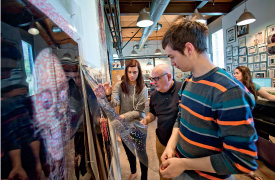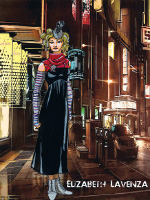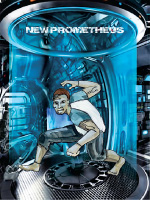Body. Networks. Memory.
By Geoff Gehman ’80 | Photography by Chuck Zovko | Illustrations by Costume Designer Erin Hopwood
In April, audiences will walk through, watch, and experience a multi-layered universal story of love, hubris, identity, and inventing the other.
The Williams Arts Campus will become a massive multi-media, multiple-venue laboratory embodying one of the great and persistent myths of the modern era. Nearly 70 members of the Lafayette community will present a sense-surrounding, time-tripping, free-wheeling version of Frankenstein, Mary Shelley’s 19th-century novel about the thrilling, terrifying consequences of fooling around with fate.

Leslie Tintle ’16 (L-R), Prof. Kerns, Ben Williamson ’16, and Allison Reich ’15 review artwork.
Imagine Victor Frankenstein as a pill-popping NASA alumnus developing brain devices for controlling blood pressure and tweeting. Imagine his Creature retreating to a place of innocence to relieve the murderous stress of being a bionic, heroic villain. Imagine Shelley leaving her semi-hippie pad in Switzerland to watch her characters fight on a frozen sea featuring dancing icebergs.
The intellectual collaboration of about 20 faculty members and 20 students from a wide range of academic disciplines as well as some staff and alumni began when Ed Kerns, professor of art and producer, first had the idea in summer 2014. He says it arose from his interest in the dynamics of memory, particularly “when we recall something, it is never the same way twice.” The story of Frankenstein struck him as an intriguing way to structure the project. Suzanne Westfall, professor of English and director of the arts, is the performance director.
Students in the course Making Theater: Frankenstein 2029, co-taught by Kerns and Westfall this semester, are also preparing for the April 22-25 performance. They are creating costumes, sculptures, and sets, and composing a script for a play that will be performed in 248 N. Third St. Artists from Hypersonic, a New York City based design studio, came to campus to work with the class. The group blends art, design, technology, engineering, and architecture to create sculptures, machines, and interactive experiences.
Jenna Seybert ’15 is promoting the project to enhance her major in integrated marketing and design. Madison Murray ’16, director of studio productions, is working on her first public theater project. Lia Embel ’17 is premiering as a photographer, painter, and performer. She’s cast as Elizabeth Lavenza, Frankenstein’s compassionate wife, who is killed by the Creature to punish Victor for his lack of compassion.


“It’s not as much a play as a structure where things happen,” says Kerns. “It’s an examination of transhumanism, an exploration of field theory. You’re looking into this field to see how this thing might go. You don’t try to bend it. You let it take its course—the successes and the failures, the beauty and the horror.”
The project is a three-part experiment: a collegial collaboration among teachers and students who rarely collaborate with one another due to the traditional academic structure, an entertaining expansion of the College’s mission to infuse the arts across the curriculum, and a forum for debating how humanity is improved and impaired by technology. A pedagogical leap into uncharted territory, it brings together new and emerging technologies.
“It is large, robust, unpredictable, and contradictory,” says Kerns, “much like the lives we live, and without a safety net for the actors. It’s about the illusion of advancement and about the transcendent nature of human connectivity. The spectators will take away what they can find to attach meaning to from the sites, scenes, and experiential moments within the venues.”
The participants—whose intellectual perspectives range from art to science to engineering to philosophy—are asking questions as a group that cannot be asked by just one discipline. “Centering on the making of an original work allows us to explore these issues more deeply,” says Kerns, “and teaches students how to prepare for the deep unknown and ambiguity of the world.”
Field Guide to the Venues

MARY SHELLEY’S BEDROOM
Mary Armstrong is making her acting debut, doing what she tells her students to do: stretch your comfort zone. At least she’s familiar with her character: the ghost of Mary Wollstonecraft, a radical novelist, philosopher, and lover who died 10 days after giving birth to Mary Shelley. Wollstonecraft’s 1792 treatise A Vindication of the Rights of Woman: with Strictures on Political and Moral Subjects is a touchstone of feminism and a touchstone in Armstrong’s classroom. In fact, she’s teaching it this semester.
Wollstonecraft’s manifesto addresses “the question of what it means to be fully human and what it would mean if we started treating women as humans,” says Armstrong, an associate professor of English and women’s and gender studies. “Sort of rings a Frankenstein bell, doesn’t it?”
Armstrong is thesis adviser for Julia Guarch ’15, who is preparing a paper on designing and directing Shelley’s bedroom. These roles are a customized fit for the creator of Lafayette’s only major in capturing gender in the arts.
Guarch envisions Shelley’s bedroom as “a hippie-wannabe pad” with books of slam poetry and posters about black power and women’s lib. The décor will illustrate Shelley’s career as a revolutionary writer and public figure, a worthy rival to her husband, poet Percy Bysshe Shelley, and Lord Byron, the couple’s poetic, romantic partner. The space will double as Guarch’s first lab for testing her theory that set design can promote social justice.
Guarch triples as the production’s patient advocate, a dispenser of crackerjack energy and firecracker ideas. “I’m willing to move things around to get things done,” she says. “I want to get people excited about and involved in interdisciplinary projects that are cool and beneficial. Art not only makes you think, it makes you keep on thinking.”

Jim Toia (far left) presents a construction sketch for Walton’s ship venue, which will feature Robert Mattison (third from left), Metzgar Professor of Art, as Capt. Walton.
WALTON’S SHIP
Jim Toia is an installation artist in charge of building an installation of the ship where Frankenstein unfurls his crazy story of making a man from corpse parts while recuperating from a nearly fatal battle with his Creature on an ocean of ice. According to Toia, spectators will be able to walk around a two-level, wood-and-canvas vessel framed by the Ahart Family Arts Plaza’s I-beams. Every 15 to 20 minutes they will watch the ship surrounded, or locked, by icebergs represented by dancers.
Toia has plenty of co-captains. The dancing icebergs are directed by Ben Munisteri, the College’s choreographer-in-residence. Production composer Tom DiGiovanni ’96 is conjuring the cracking of ice and nerves. Architect Joe Biondo, who designed the Ahart Plaza and the adjacent Williams Visual Arts Building, is helping Toia build the ship. “I’m coming with an open mind,” he says, “and a lot of naiveté.”
“We’re aiming for a cinematic, operatic experience,” says Toia, who directs Lafayette’s Community-Based Teaching program. “We’re going to celebrate movement and the power and majesty of nature defining our predicament. I love the idea that we have the freedom to push things much further than is reasonable. If it works, it will be a blast. If it doesn’t work as well as we’d like it to work, well, as Ed likes to say: Sometimes it’s better to have a grand failure than a mediocre success.”
BIRTH MYTH HALL
David Veshosky co-directs the production’s strangest place, a space for examining all kinds of creation: asexual, mechanical, electronic, divine. He joined the production mainly because he wanted to work again with the dynamic duo of Jim Toia and Ed Kerns, his collaborators on artistic/economic projects in Easton and New Orleans. “Ed and Jim really make people think outside their silos,” says Veshosky, whose teammates include his wife, Kathy Clayton, a part-time instructor of English. “They come at things from a different perspective. They make you see the broader view; they get your juices fired up.”
Veshosky, associate professor of civil and environmental engineering, is firing up his construction management class with a futuristic, Frankensteinian experiment. Students will use a hypothetical nanocomputer implanted in the skin—a 2020 device—in an attempt to finish a project four months early and claim a $100,000 bonus. Veshosky’s name for the electronic tattoo? The iToo.
Veshosky’s fellow leader, Diane Shaw, is planning to tattoo the hall with reproduced excerpts from elaborate artist books she curates as director of special collections and College archivist. Imagine, she says, Dr. Jekyll and Mr. Hyde, his chemically induced monstrous alter ego, roaming the mythic birth canal with Dolly, the first cloned sheep. Imagine an umbilical cord of words and images “shaped and swirled and collapsing and spewing.”
For Suzanne Westfall, the hall is a theatrical mobile device for exploring Shelley’s warning that technology is barren without nature, nurture, and education. “Without those elements in the middle of your creature it can’t be fully human,” she says. “You can make it walk and talk and squeal and squawk, but you can’t make it have awe and love without spirit and anima and art.”

Ben Williamson ’16 (left) and Scott Kovacs, a
part-time student, adjust lights and wiring for one
of the venue sets.
PLACE OF INNOCENCE
Eric Ziolkowski signed up for Frankenstein 2029 partly because he wanted to trade the shelter of solitary scholarship for the scarier, potentially more exciting shelter of a creative team. Appropriately enough, the professor of religious studies is a coordinator of a shelter from the shocks of science, industry, and humanity. Victor Frankenstein, being played by Ben Williamson ’16, an art and film and media studies major, may seek solace in projected images from William Blake’s Songs of Innocence and Songs of Experience. The Creature may be calmed by spoken excerpts from Milton’s Paradise Lost, one of Ziolkowsk’s favorite books. Alex Merriman ’16, an art major, is cast as the Creature.
One of Ziolkowski’s favorite shelters is a College-owned cross country course, a beautifully mercurial corn field he’s walked in withering heat and blizzard. Another favorite sanctuary is the Frankenstein franchise. He grew up on the black-and-white horror movies, including the comedy with Abbott & Costello. He’s taught Shelley’s novel in a course on religion and fantasy. His daughters dig Victor and the Creature, too. “Frankenstein,” he says with a laugh, “is a household friend.”
Composer DiGiovanni is working with Ziolkowski on simulating the sounds of mental shelters. The high-school music teacher is aiming for a sort of cerebral soundtrack. “I want to create neurological spaces. I want to get into people’s heads. I want the composition to reflect not only what they’re thinking, but what they’re feeling.”

VICTOR FRANKENSTEIN’S LAB
Nancy Waters is perfectly typecast as a director of the headquarters of VictorNeuroTech, where lab assistants read from Shelley’s novel and several actors play Frankenstein simultaneously. The associate professor of biology certainly knows her way around a lab. She teaches ecology and reproductive technology, specialties that overlap Victor’s pioneering efforts in extracting alien DNA from rocks and equipping avatars with human consciousness. She’s also well acquainted with flamboyant characters; her acting repertoire ranges from Evita Peron to Van Helsing, the male vampire stalker in Dracula.
Waters describes herself as an “old-fashioned, straightforward scientist.” Not surprisingly, she’s deeply ambivalent about cloning and other Frankensteinian advances. “Are we being disrespectful of the wonder of life in trying to recreate it? Are genetics good or evil or at least non-evil? I’m not sure that newer and faster is better.”
Mai Ao ’16 shares Waters’ healthy skepticism. The computer science and art major is happy to design the lab’s projections, videos, and proposals for brain accessories. Yet he’s not sure that a neural blood-sugar monitor will make a person happier or even healthier.
“I have a problem with the obsession with instant gratification through instant communication,” says Ao. “I don’t see electronic devices as an essential part of our well-being. They may make our lives easier but they won’t help us live with each other peacefully.”
Frankenstein 2029 is good medicine for Scott Kovacs, a student group leader in Victor’s Lab. The production continues a four-year odyssey for the part-time non-traditional student, who has fond memories of watching Frankenstein films with his father. He re-entered college after a decade-long absence, left his job in a car-parts warehouse, interned with an interactive film/play about a real-life billboard-sitting contest, learned he had lymphoma in an emergency room, was saved from death by emergency surgery, endured six cycles of chemotherapy and 21 days of radiation, went into remission, and agreed to help light venues for the production.
Kovacs, in short, personifies Shelley’s story of regeneration through technology and bravery.
“This project is deeply woven into the fabric of who I am,” he says. “I don’t need to have any goals; I don’t have to have a desired effect. I just want to see how it transforms people, including me. I think it’s beautiful.”